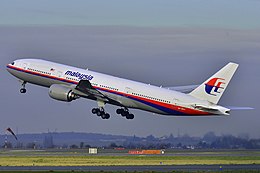
Back Malaysia Airlines-vlug 370 Afrikaans الخطوط الجوية الماليزية الرحلة 370 Arabic মালয়েছিয়া এয়াৰলাইন্স ফ্লাইট ৩৭০ Assamese Рейс 370 Malaysia Airlines AV Malayziya Hava Yolları reys 370 Azerbaijani Полет 370 на Малайзия Еърлайнс Bulgarian মালয়েশিয়া এয়ারলাইন্স ফ্লাইট ৩৭০ Bengali/Bangla Vol 370 de Malaysia Airlines Catalan گەشتی ئاسمانی مالیزیا ٣٧٠ CKB Let Malaysia Airlines 370 Czech
 The missing aircraft pictured in December 2011 | |
| Disappearance | |
|---|---|
| Date | 8 March 2014 |
| Summary | Inconclusive, some debris found |
| Site | Indian Ocean, most likely southern |
| Aircraft | |
| Aircraft type | Boeing 777-200ER |
| Operator | Malaysia Airlines |
| IATA flight No. | MH370 |
| ICAO flight No. | MAS370 |
| Call sign | Malaysian 370 |
| Registration | 9M-MRO |
| Flight origin | Kuala Lumpur International Airport |
| Destination | Beijing Capital International Airport |
| Occupants | 239 |
| Passengers | 227 |
| Crew | 12 |
| Fatalities | 239 (presumed) |
| Survivors | 0 (presumed) |
| Malaysia Airlines Flight 370 |
|---|
Malaysia Airlines Flight 370 (MH370/MAS370)[a] was an international passenger flight operated by Malaysia Airlines that disappeared from radar on 8 March 2014, while flying from Kuala Lumpur International Airport in Malaysia to its planned destination, Beijing Capital International Airport in China.[1] It has not been determined what caused its disappearance.
The crew of the Boeing 777-200ER, with registration mark 9M-MRO, last communicated with air traffic control (ATC) around 38 minutes after takeoff when the flight was over the South China Sea. The aircraft was lost from ATC's secondary surveillance radar screens minutes later, but was tracked by the Malaysian military's primary radar system for another hour, deviating westward from its planned flight path, crossing the Malay Peninsula and Andaman Sea. It left radar range 200 nautical miles (370 km; 230 mi) northwest of Penang Island in northwestern Peninsular Malaysia.
With all 227 passengers and 12 crew aboard presumed dead, the disappearance of Flight 370 was the deadliest incident involving a Boeing 777, the deadliest of 2014, and the deadliest in Malaysia Airlines' history until it was surpassed in all three regards by Malaysia Airlines Flight 17, which was shot down while flying over Ukraine four months later on 17 July 2014.
The search for the missing airplane became the most expensive search in the history of aviation. It focused initially on the South China Sea and Andaman Sea, before a novel analysis of the aircraft's automated communications with an Inmarsat satellite indicated that the plane had traveled far southward over the southern Indian Ocean. The lack of official information in the days immediately after the disappearance prompted fierce criticism from the Chinese public, particularly from relatives of the passengers, as most people on board Flight 370 were of Chinese origin. Several pieces of debris washed ashore in the western Indian Ocean during 2015 and 2016; many of these were confirmed to have originated from Flight 370.
After a three-year search across 120,000 km2 (46,000 sq mi) of ocean failed to locate the aircraft, the Joint Agency Coordination Centre heading the operation suspended its activities in January 2017. A second search launched in January 2018 by private contractor Ocean Infinity also ended without success after six months.
Relying mostly on analysis of data from the Inmarsat satellite with which the aircraft last communicated, the Australian Transport Safety Bureau (ATSB) proposed initially that a hypoxia event was the most likely cause given the available evidence, although no consensus has been reached concerning this theory among investigators. At various stages of the investigation, possible hijacking scenarios were considered, including crew involvement, and suspicion of the airplane's cargo manifest; many disappearance theories regarding the flight have also been reported by the media.
The Malaysian Ministry of Transport's final report from July 2018 was inconclusive. It highlighted Malaysian ATC's failures to attempt to communicate with the aircraft shortly after its disappearance. In the absence of a definitive cause of disappearance, air transport industry safety recommendations and regulations citing Flight 370 have been implemented to prevent a repetition of the circumstances associated with the loss. These include increased battery life on underwater locator beacons, lengthening of recording times on flight data recorders and cockpit voice recorders, and new standards for aircraft position reporting over open ocean.
Cite error: There are <ref group=lower-alpha> tags or {{efn}} templates on this page, but the references will not show without a {{reflist|group=lower-alpha}} template or {{notelist}} template (see the help page).
© MMXXIII Rich X Search. We shall prevail. All rights reserved. Rich X Search